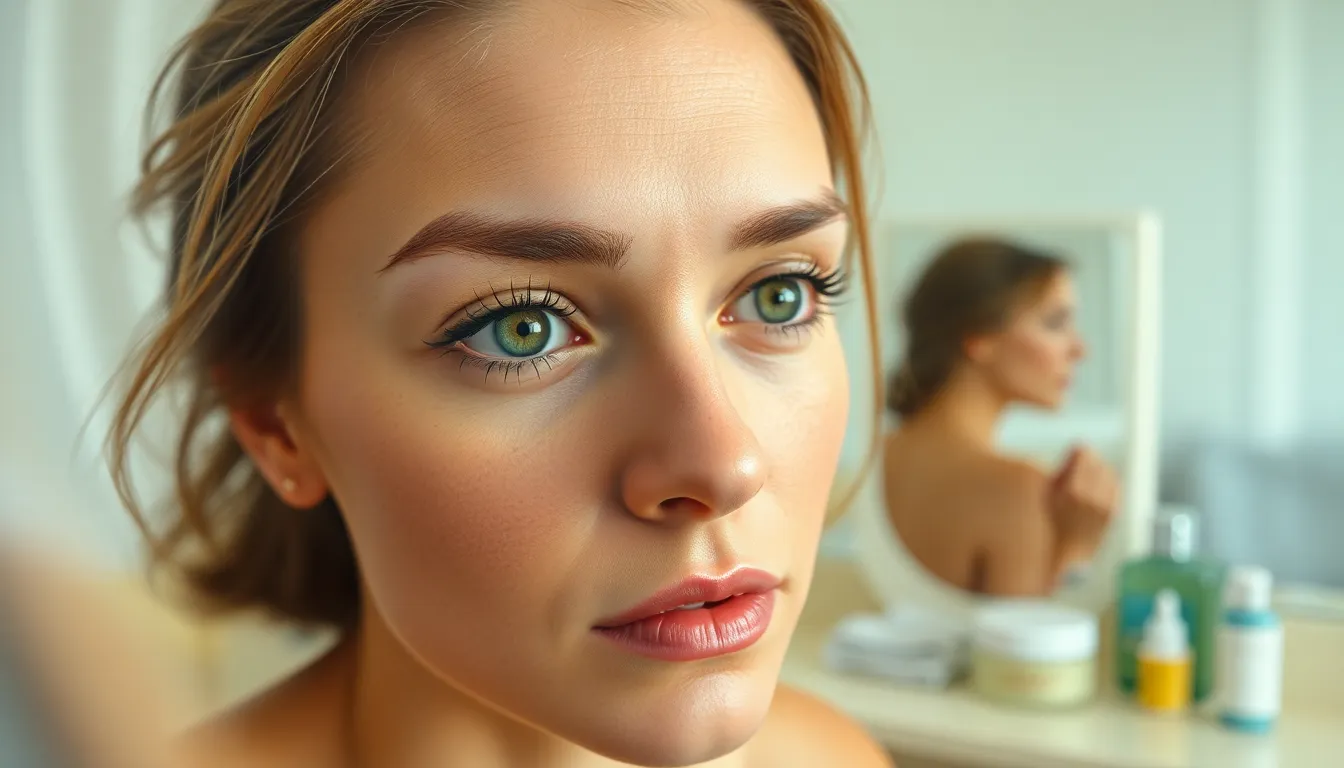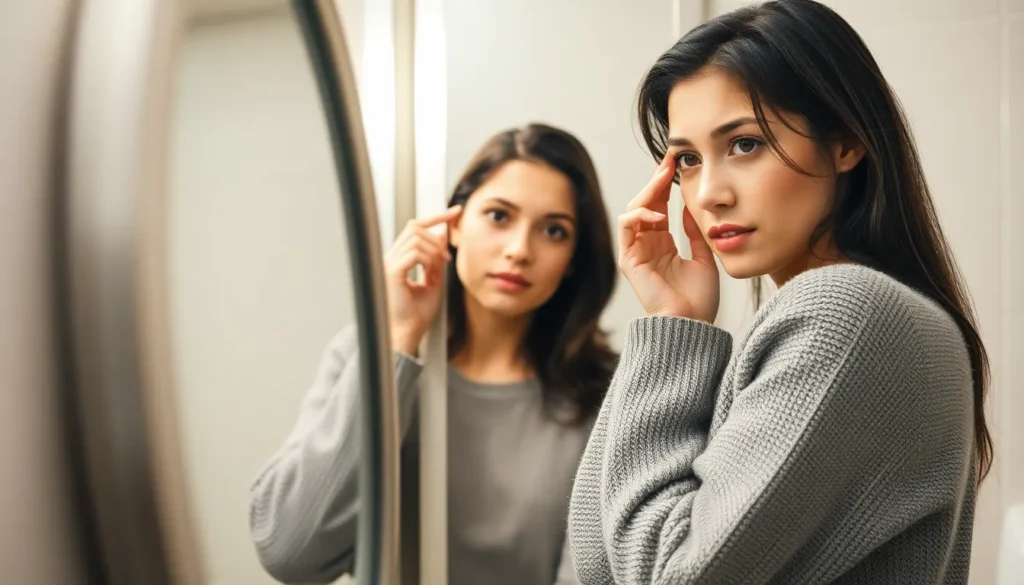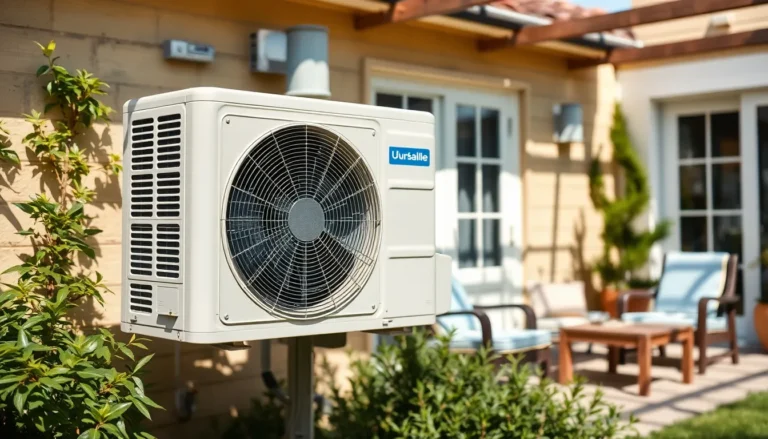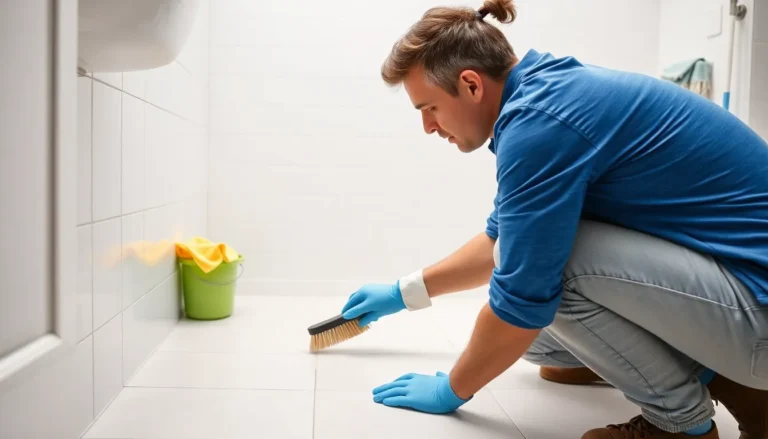Ever looked in the mirror and thought, “What in the world is that bump on my eyebrow?” If it’s not a pimple, it can feel like a mystery worthy of a detective novel. While some might panic and reach for the nearest spot treatment, it’s essential to know that not all eyebrow bumps are created equal.
Table of Contents
ToggleUnderstanding Eyebrow Bumps
Eyebrow bumps can arise from various causes. A cyst forms when skin cells grow inward, creating a sac filled with fluid. Another possibility involves a result of an inflamed hair follicle, commonly known as folliculitis. Allergic reactions to cosmetics or skincare products might also cause irritation and swelling around the eyebrow area.
Infections can develop in the eyebrow region as well. Bacterial or viral infections lead to redness and sometimes pus formation. Dermatitis may present as a bump while causing itchiness and discomfort. Certain skin conditions like eczema or psoriasis can manifest in this area too, resulting in raised patches on the skin.
Physical trauma often contributes to bumps above the eyebrow. An injury or a bruise can lead to swelling as the body responds to damage. Fibromas, benign tumors, occasionally appear in or around the eyebrow, resembling bumps but requiring no treatment unless they become bothersome.
Some individuals may experience differential bumps due to sebaceous gland proliferation. These glands can block and lead to small, painless bumps, presenting no significant health risks. Moles might also arise in this region, which usually need monitoring for changes in size, shape, or color.
Recognizing the distinctions in these bumps helps determine appropriate responses. Instead of jumping to conclusions about serious issues, understanding the nature and characteristics of the bump facilitates better management. Regular examination and self-awareness encourage early identification of concerning changes.
Common Causes of Bumps on Eyebrows

Understanding the common causes of bumps on eyebrows helps in identifying and addressing them effectively.
Cysts
Cysts often form under the skin, appearing as smooth, round bumps. These sac-like structures can contain fluid or semisolid material. Sebaceous cysts frequently occur due to blocked sebaceous glands, resulting from inflammation or injury. They may feel tender but typically remain painless. Most cysts don’t require treatment unless they become infected or bothersome. Regular monitoring is essential to ensure they don’t change.
Folliculitis
Folliculitis involves inflammation of hair follicles, often causing red, swollen bumps around the eyebrow area. Triggers include bacterial infections, fungal overgrowth, or irritation from grooming products. Scratching or tight clothing may further aggravate existing follicles. Affected individuals often experience itching or burning sensations alongside bumps. Treatment usually consists of topical antibiotics or antifungal creams, depending on the underlying cause. Maintaining proper hygiene can help prevent flare-ups.
Dermatitis
Dermatitis encompasses various skin conditions that lead to inflammation, itching, or redness. Contact dermatitis arises from allergic reactions to cosmetics or skincare products applied near the eyebrows. Symptoms may include redness, dry patches, or irritation. Atopic dermatitis, known as eczema, can also affect the eyebrow area, leading to similar symptoms. Treatment revolves around corticosteroid creams and avoiding known irritants. Regular moisturization plays a critical role in managing symptoms.
Symptoms to Look For
Recognizing specific symptoms is crucial when identifying a bump on the eyebrow. Observing color and texture can provide important clues to the nature of the bump.
Color and Texture
Bumps on the eyebrow may vary in color and texture. Yellowish or skin-colored cysts often present as smooth and firm. Red or inflamed bumps typically indicate folliculitis or an allergic reaction, where the skin appears irritated with a rough texture. Other bumps may appear brown or black if they are moles or benign tumors. Textural variations also exist; some bumps feel hard, while others may feel soft or fluid-filled. Variations in appearance can help differentiate between benign issues and those requiring further attention.
Pain and Sensitivity
Pain levels and sensitivity usually vary based on the cause of the bump. Cysts often remain painless, while inflamed hair follicles may cause discomfort and tenderness. A bump that feels itchy or painful could indicate irritation or infection. Swelling in the surrounding area often accompanies these symptoms, signaling inflammation. Comparison of affected areas helps determine whether the bump is associated with other symptoms like redness or warmth. Prompt assessment is essential if pain escalates or sensitivity increases significantly.
Diagnosis and Treatment Options
Identifying the right diagnosis and treatment for a bump on the eyebrow requires clarity on its characteristics.
Home Remedies
Warm compresses can ease discomfort, especially for bumps caused by inflammation or irritation. Gentle washing with mild soap keeps the area clean, reducing the risk of infection. Aloe vera, known for its soothing properties, may help relieve inflammation and promote healing. Tea tree oil, diluted with a carrier oil, acts as a natural antibacterial treatment. Keeping the area moisturized with non-comedogenic creams can prevent dryness and irritation. Regular monitoring of the bump’s appearance ensures early identification of any concerning changes.
Professional Treatments
Dermatologists often recommend corticosteroid injections for reducing inflammation associated with more significant bumps, like those caused by dermatitis or folliculitis. Prescription topical medications may address bacterial or fungal infections effectively. Surgical excision might be necessary if the bump is a cyst or benign tumor causing discomfort. Cryotherapy, involving the application of extreme cold, treats certain skin lesions effectively. If an allergic reaction is suspected, allergy testing can help identify triggers and prevent future occurrences. Regular consultations with a healthcare provider ensure appropriate management and care.
When to See a Doctor
Seeing a doctor becomes essential if a bump on the eyebrow changes in size, color, or texture. Persistent bumps lasting more than two weeks warrant medical evaluation. Sudden increases in pain or tenderness indicate possible infection and should prompt immediate attention. Additionally, if the bump presents with drainage of pus or significant redness, seeking professional advice is crucial.
Notably, bumps accompanied by other symptoms like fever or systemic illness require urgent medical care. Individuals experiencing frequent headaches or vision changes alongside eyebrow bumps must consult a healthcare provider without delay. Suspicion of a cyst turning painful or swollen means treatment may be necessary to prevent complications.
A dermatologist’s expertise is vital for accurate diagnosis. They can perform tests to identify underlying conditions such as allergic reactions or infections. Monitoring any sudden changes in moles is equally important, as irregularities can signal skin concerns needing further investigation.
Factors like family history of skin cancer can influence the decision to seek care. Individuals with skin conditions should maintain regular appointments to track any new developments. Consequently, proactive management and consultation promote better outcomes for eyebrow bumps that raise concern.
Understanding the nature of a bump on the eyebrow is crucial for effective management. By recognizing the various causes and symptoms, individuals can make informed decisions about treatment options. Whether it’s a cyst, folliculitis, or another condition, knowing when to seek professional help can lead to better outcomes. Regular self-examination and awareness of changes in size, color, or texture are essential. With the right approach and guidance from a healthcare provider, most eyebrow bumps can be addressed effectively, ensuring peace of mind and maintaining skin health.






